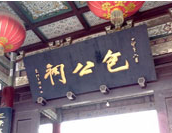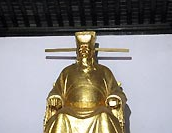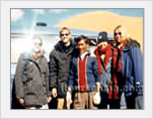
Baogong Memorial Hall Guide
-Travel to Baogong Memorial Hall Baogong Memorial Hall a special memorial hall to commemorate Bao Zhen(999-1062) in the Northern Song Dynasty (960-1127), is located in Fragrant Flower Mound of Baohe Park, Hefei. It was first built in the period 1488 to 1505 of the Ming Dynasty (1368-1644). These buildings were rebuilt in 1882 and 1946 respectively.
Baogong Memorial Hall a special memorial hall to commemorate Bao Zhen(999-1062) in the Northern Song Dynasty (960-1127), is located in Fragrant Flower Mound of Baohe Park, Hefei. It was first built in the period 1488 to 1505 of the Ming Dynasty (1368-1644). These buildings were rebuilt in 1882 and 1946 respectively.
 Fragrant Flower Mound used to be the place where Bao Zhen studied. During the Ming Dynasty, Song Guangming, the governor of Hefei, saw this scenic spot and the ancient temple into Baogong Academy. In the memorial hall display the statue of Baogong, stone carved image, euhural relics and relevant materials. By the side of the memorial hall, there is a pavilion with a well in it. The well is named Honest and Clean Well (Incorruptible Well). Legend has it that those officials who have not been honest and clean dare not to drink the water from the well. Bao Zhen, popularly known as Bao Gong (Lord Bao), was prefect of Kaifeng, capital of the Northern Song Dynasty. He was famous in popular legend as an upright and capable official and fearless, impartial judge with a knack of passing true verdicts in all the cases he tried. The people called him "Just Judge Bao" in the Northern Song Dynasty.
Fragrant Flower Mound used to be the place where Bao Zhen studied. During the Ming Dynasty, Song Guangming, the governor of Hefei, saw this scenic spot and the ancient temple into Baogong Academy. In the memorial hall display the statue of Baogong, stone carved image, euhural relics and relevant materials. By the side of the memorial hall, there is a pavilion with a well in it. The well is named Honest and Clean Well (Incorruptible Well). Legend has it that those officials who have not been honest and clean dare not to drink the water from the well. Bao Zhen, popularly known as Bao Gong (Lord Bao), was prefect of Kaifeng, capital of the Northern Song Dynasty. He was famous in popular legend as an upright and capable official and fearless, impartial judge with a knack of passing true verdicts in all the cases he tried. The people called him "Just Judge Bao" in the Northern Song Dynasty.
 Like most temples in China, the layout contains several courtyards flanked with side halls. Artificial rocks, springs and pavilions were built to enhance the surrounding scenery. On the gable walls of the four sides are four large painted murals which mirror the significant achievements of Lord Bao. A rubbing of Lord Bao's stone carving statue lies in the second Hall. An inspiring poem written by Lord Bao which represents his idea and resolution about his official career is hung in the display cabinet. The family precepts drafted by Lord Bao is also shown in the display cabinet, saying that the offspring of his family, once found corrupted in the official posts should not be allowed to return to the family, should not be buried in the family ancestral cemetery and those who do not obey this will not be his offspring. In the east and west two subsidiary halls, the sculptures and pictures connected with the stories and tales about Bao Zheng are exhibited and the three copper cutters used to punish the convicted are also on display.
Like most temples in China, the layout contains several courtyards flanked with side halls. Artificial rocks, springs and pavilions were built to enhance the surrounding scenery. On the gable walls of the four sides are four large painted murals which mirror the significant achievements of Lord Bao. A rubbing of Lord Bao's stone carving statue lies in the second Hall. An inspiring poem written by Lord Bao which represents his idea and resolution about his official career is hung in the display cabinet. The family precepts drafted by Lord Bao is also shown in the display cabinet, saying that the offspring of his family, once found corrupted in the official posts should not be allowed to return to the family, should not be buried in the family ancestral cemetery and those who do not obey this will not be his offspring. In the east and west two subsidiary halls, the sculptures and pictures connected with the stories and tales about Bao Zheng are exhibited and the three copper cutters used to punish the convicted are also on display.
More Attractions in Hefei
Your Question & Quick Answer*We welcome and appreciate your questions & reviews
Booking Procedures | Terms & Conditions | Payment Methods | Links | Site Map | About Us | Contact Us | Travel Agent
Copyright 2008, All rights reserved.. itourbeijing.com professional china travel guide and china travel service
TEL: 86-10-85711972 (Universal) 1-888-288-9328 (North America) E-mail: contact@itourbeijng.com
Tours Index | China Tours | Beijing Tours | Xi'an Tours | Shanghai Tours | Guilin Tours | Tibet Tours
China Travel | Beijing Travel | Shanghai Travel | Xi'an Travel | Guilin Travel |Beijing Map
China Golf | Beijing Golf | Shanghai Golf | Xiamen Golf | The Great Wall Travel | Yangtze Cruise | Travel Picture



